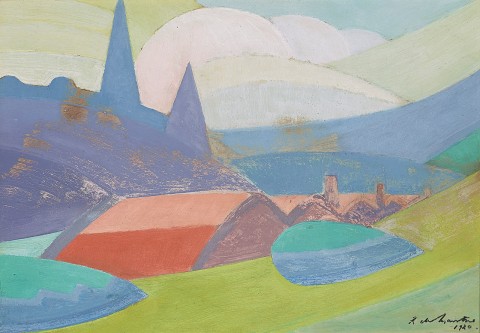STUDY FOR A PAINTED PICTURE OF THE UNIVERSE, 1920
ROY DE MAISTRE
oil on cardboard
19.0 x 25.5 cm
signed and dated lower right: R. de Maistre / 1920
Sir John Rothenstein, London, acquired directly from the artist
Thence by descent
Lucy Dynevor, London
Sotheby's, London, 26 February 2003, lot 86 (as ‘Landscape with Church Spire’)
Private collection, Melbourne
Deutscher~Menzies, Melbourne, 8 September 2004, lot 54 (as ‘Landscape with Church Spire, Sydney’)
Private collection, Melbourne
possibly: Society of Artists Spring Exhibition, Education Department’s Art Gallery, Sydney, open 18 September 1920, cat. 72 (as ‘Landscape’)
A Painted Picture of the Universe, 1920 – 34, oil on board, 50.7 x 40.6 cm, in the collection of the National Gallery of Victoria, Melbourne
In August 1919, Roy de Maistre mounted the provocative Colour in Art exhibition in Sydney with his artist-colleague Roland Wakelin. Alongside high-coloured, flat-planed images of the Harbour and environs, the two artists exhibited the first non-objective abstractions ever painted in Australia. Only one of these is known to survive, Rhythmic Composition in Yellow Green Minor, 1919 (Art Gallery of New South Wales, Sydney), a swirling arrangement that seeks to illustrate the artist’s quest for a universal spirituality revealed through art. The next year, de Maistre began another significant work in this series, A Painted Picture of the Universe, 1920 – 34, (National Gallery of Victoria, Melbourne) in which he expands on an earlier landscape view to create a mesmerising image of the interlinked celestial forces that he interpreted as underpinning the natural world. That original landscape is the work offered here, Study for A Painted Picture of the Universe, 1920.
In this image, de Maistre has already reduced the scene into one of flattened planes, triangular forms and curves. It is suggestive of a semi-rural landscape with undulating hills and the possible curve of a lake apparent in the mid section. A sequence of four houses runs horizontally with three accented by chimneys. To the left, another hill rises steeply with two majestic trees reduced to their barest form as triangles; and the multiple arcs formed by the clouds and sun surmount all. The two large trees have previously been mis-interpreted as church spires, which is understandable considering the spiritual quest evoked by A Painted Picture of the Universe. The colours used by de Maistre are more muted when compared to those from the ‘Colour in Art’ period, but his total control of colour harmonies (which he equated to musical scales) is evident, running from soft violet and blue through to a rich citric green, punctuated by warm terracotta: ‘they are beautiful patterns and they ‘carry'.’1 The artist often worked serially through multiple versions of the same motif, synthesising and clarifying his original design as he proceeded. Comparisons between this study and the final abstraction make this strategy abundantly clear.
Originally christened Roi de Mestre, the artist changed the spelling to ‘de Maistre’ from mid-1931; and Study for A Painted Picture of the Universe is signed using this later form (as is the larger abstraction). This indicates that he took both works with him when he relocated permanently to London after March 1930. De Maistre subsequently gifted this painting (when it is presumed he actually signed and dated it) to the noted British curator Sir John Rothenstein, the Director of the Tate Gallery from 1938 to 1964. Their friendship possibly started as early as 1923 when de Maistre first visited London bearing a letter of introduction to his father, the society artist Sir William Rothenstein. In 1960, Sir John wrote the catalogue essay for the de Maistre’s major retrospective held at the renowned Whitechapel Art Gallery in London; and Study for A Painted Picture of the Universe is an enduring symbol of their mutual admiration.
1. ‘Pictures set to music’, Daily Telegraph, Sydney, 9 August 1919, p. 8
ANDREW GAYNOR
